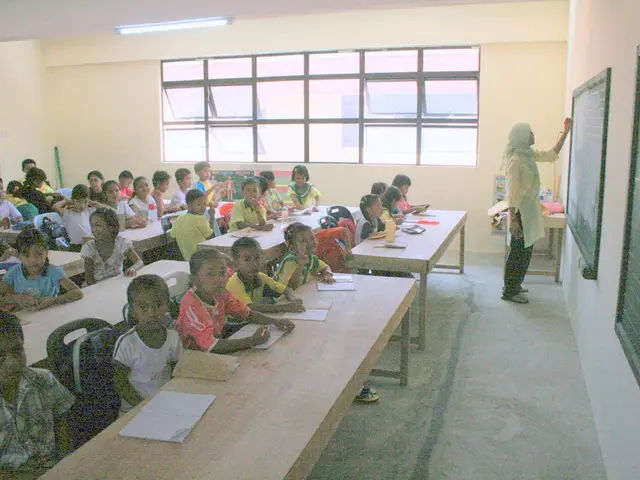Tech Troubles in Class: Overworked Teachers and Digital Disruptions
- *
Struggles of Teachers in the Digital Age: Challenges They Face - Digitalisation-Induced Stress Impact on Educators: An Examination of Its Effects
Teaching in a digital age isn't always smooth sailing. Network outages, printer problems, and software updates — the tech headaches keep teachers on their toes even after school hours. Thilo Hartmann, the chairman of the Education and Science Union (GEW) in Hesse, calls it a "digital deluge."
Teachers prepare their lessons, expecting the technology to just work. But when it doesn't, they're left scrambling, juggling their teaching duties with troubleshooting. "In schools, digitalization brings on heaps of overtime and digital stress," Thilo says.
At many schools, the tech-savvy teachers step up to provide IT support on the side. A handful of well-versed educators handle the job, but it's a mammoth task considering the multitude of devices used daily in today's classrooms.
Gazing at a sea of devices
A school with about a thousand students and over a hundred teachers possesses a towering number of devices. This additional burden can't merely be handled on the side. "Imagine a corporate setting with such a workload," Thilo points out. "They'd have a dedicated IT department. But in schools, we don't."
From malfunctioning computer rooms to intermittent internet connections, someone has to solve problems swiftly to ensure classes keep running as planned. Keeping devices up-to-date, installing the latest software, and securing data take time and patience. It's a demanding task, often requiring navigating new and complex systems.
Tech Support in Kassel
Kassel took a step towards relieving teachers by launching an "IT-Supporter@School" project. This endeavor recruited twelve IT supporters, each assigned to support six schools. "The schools can no longer cope with the technical support tasks on their own," says Mayor and Education Department Nicole Maisch (Greens). "These are teachers who aren't IT specialists but offer their help alongside their regular duties.”
IT supporter Thorben Schröder explains his role. He's the go-to person for schools, tackling simple issues on site and being a reliable point of contact for complex queries. He and his colleagues make regular visits and respond in case of emergencies.
"If my iPad breaks, I'm in trouble," says Carsten Horstmann, the deputy headmaster of the Johann-Amos-Comenius School. The arrival of IT supporters means quick problem resolution, allowing teachers to focus on teaching rather than technical hiccups.
Modern teaching aided by digital tools
The digital infrastructure in schools is improved with the backing of federal and state governments as part of the Digital Pact I. The goal is simple: provide teachers with digital tools that work reliably so they can focus on their primary job—teaching.
The Hessian Ministry of Culture acknowledges the challenges of digitalization. "The digitalization of schools shows the complexities that come with the introduction of modern technologies," says the ministry. "Progress has been made in areas like structural adaptation, skill building, and resource allocation. However, ongoing advancements require continuous efforts to successfully navigate this evolution."
In the eyes of the ministry, digitization serves to support teachers in administrative chores and improve their work in the classroom by enabling individualized student support. "Digital tools provided by the state and school authorities alleviate teachers from our perspective. In the realm of IT equipment, the state advocates technical support that relieves teachers in their day-to-day tasks," the ministry states.
Strides in digitalizing Hessian schools have been considerable. "Especially due to the additional funds provided by the state, school IT infrastructure in Hesse is now equipped to support modern, digitally-enhanced teaching," the ministry says.
A Path Forward for Stressed Teachers
GEW acknowledges the progress made in digitizing schools but identifies areas for further improvement. "The digitization of schools has received a boost due to the pandemic. Yet, we still have a long way to go," says Hartmann. The union calls for funds to address the backlog in the coming years, given the imminent need to replace aging equipment. Hartmann also advocates for enhanced media education, emphasizing critical thinking when it comes to using digital tools.
In an ideal world, all schools would have equal access to the tools needed for modern teaching. But in the face of challenges and setbacks, the journey towards a smoothly-running edtech ecosystem for teachers continues.
- The Education and Science Union (GEW) proposes allocating funds for media education and replacing aging equipment to further advance the digitalization of schools, ensuring all teachers have the necessary resources for vocational training in technology and education-and-self-development, which are vital for preparing students for the modern workforce.
- To alleviate tech troubles in class, GEW supports implementing comprehensive community policies, including providing vocational training for teachers in technology and supporting them with dedicated IT personnel, freeing them from tech-related issues so they can focus on delivering quality education and student-centered learning experiences.







